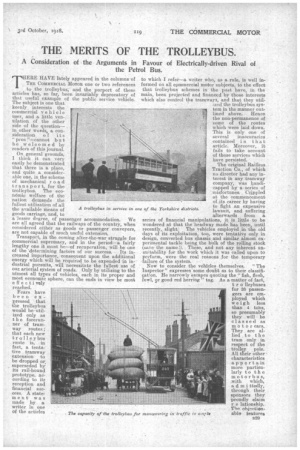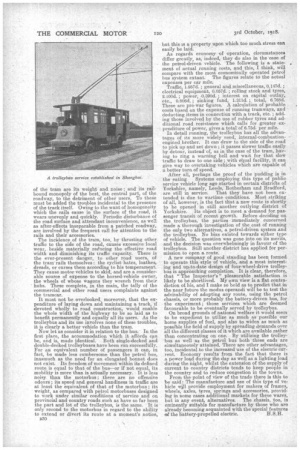THE MERITS OF THE TROLLEYBUS.
Page 9

Page 10

If you've noticed an error in this article please click here to report it so we can fix it.
A Consideration of the Arguments in Favour of Electrically-driven Rival of the Petrol Bus.
THERE HAVE lately appeared in the columns of TEE COMMERCIAL MoToft one or two references to the trolleybus, and the purport of these articles has, so far, been invariably deprecatory of that useful example of the public service vehicle. The subject is one that keenly interests the commercial vehicle user, and a little ventilation of the other side of the question— in other words, a consideration of its "pros "—cannot b u t be welcomed by readers of this journal.
On general grounds, I think it can very easily be demonstrated that there is a place, and quite a considerable one, in the scheme of mechanical road transport, for the trolleybus. The econdmic welfare of the nation demands the fullest utilization of all the available means of goods carriage, and, to a lesser degree. of passenger accommodation. We are all agreed that the railways of the country, when considered either as goods or passenger conveyers, are not capable of much useful extension. Transport, in the coming after-the-war struggle for commercial supremacy, and in the period—a fairly lengthy one it must be—of recuperation, will be one of the 'determining factors of our success. Its increased importance, consequent upon the additional energy which will be required to be expended in industrial pursuits, will necessitate the fullest use of our, arterial system of roads. Only by utilizing to the utmost all types of vehicles, each in its proper and most economic sphere, can the ends in view be most effectively reached.
Fears have been expressed that the trolleybus
would be-utilized only as
the forerunner of tramway routes ; that each new trolleybus route is, in fact, a tents,tive tramway extension to be dropped or,
_ superseded by its rail-bound prototype, according to its reception and financial success. A statein ent was made by a writer in one of the articles
to which I refer—a writer who, as a rule, is well informed on all cgmmercial motor subjects, to the effect that trolleybus schemes in the past have, in the main, been projected and financed by those interests which also control the tramways, and that they util
ized the trolleybus system in the manner outlined above: Hence the non-permanence of some of the routes which were laid down. This is only one of several inaccuracies contained in that article. Moreover, it fails to take account of those services which have persisted.
The original Railless Traction Co., of which no director had any interest in any tramway company, was handicapped by a series of misfortunes. Crippled at the commencement of its career by having to fight an expensive lawsuit, and suffering afterwards from a
series of financial manipulations, it is little to be wondered at that the 'headway made has been, until recently, slight. The vehicles employed in the old days ys of its exploitation, too, were tentative only in design, converted bus chassis and similar almost experimental tackle being the bulk of the rolling stock (save the name!). These, and not any, inherent unsuitability for the work which it was called upon to perform, were the real reasons for the temporary • failure of the system.
Now to consider the vehicles themselves. "The Inspector" expresses 'some doubt as to their classification. He narrowly escapes quoting the "fish, flesh, fowl, 2r good red herring" tag. As a matter of fact, t r o lleybuses for 38 passengers are employed which weigh less than 4 tolls, so presumably they will be classed as motorcars. They are allied.to the tram only in respect of the trolley pole. All their other' characteristics appertain more particularly to the motorbus with which, a dmi ttedly, through their sponsors they 'proudly claim r e lationship. The objectionable features of the tram are its weight and noise and its railbound monopoly of the best, the central part, of the roadway, to the detriment of other users. To these must be added the troables incidental to the presence of the track itself. Owing to the want of homogeneity which the rails cause in the surface of the road, it wears unevenly and quickly. Periodic disturbance of the road surface and attendant inconvenience, as well as after-effects inseparable from a patched roadway, are involved by the frequent call for attention to the rails and their accessories.
The incidence of the tram, too, by thrusting other. traffic to the side of the road, causes excessive -local wear, beside materially reducing the effective road width and diminishing its traffic capacity. There is the ever-present danger, to other road users, of the tram rails themselves : the cyclist hates, loathes, dreads, or curses them according to his temperament. They cause motor vehicles to skid, and are a considerable source of expense to the horsed-vehicle owner, the wheels of whose wagons they wrench from their hubs. These complete, in the main, the tally of the commercial and other road users complaints against the tramcar.
It must not be overlooked, moreover? that the expenditure of laying down and maintaining a track, if devoted wholly to road construction, would enable the whole width of the highway to be so laid as to benefit permanently and equally all its users. As the trolleybus and its use involves none of these troubles, it is clearly a better vehicle than the tram.
Now let us consider it in relation to the bus. In the first place, the accommodation which it affords can be, and is, made identical. Both single-decked and double-decked trolleybuses have been run successfully. For an equivalent number of passengers it can, in fact, be made less cumbersome than the petrol bas, inasmuch as the need for an elongated bonnet does not exist. Its freedom of movement within its defined route is equal to that of the bus—or if not equal, its mobility is more than is actually necessary. It is less noisy than, the motorbus ; there are no offensive odours; its speed and general handiness in traffic are at least the equivalent of that of the motorbus ; its weight, as compared with petrol motorbuses designed to work under similar conditions of service and on provincial and country roads such as have so far been the part and lot of the trolleybus, is the same. It is only second to the motorbus in regard to the ability to extend or divert its route at a moment's notice, B30 but this is a property upon which too much stress ean easily be laid. As regards economy of operation, circumstances differ greatly, as, indeed, they do also in the case of the petrol-driven vehicle. The following is a statement of actual running costs, and this, I think, will compare with the most economically operated petrol bus system extant. The figures relate to the actual expenses per car mile.
Traffic, 1.957d.; general and miscellaneous, 0.147d. ; electrical equipment, 0.057d. ; rolling stock and tyres, ; power, .0.390d.; interest on capital outlay, etc., 0.806d. ; sinking fund, 1.311d.; total, 6.768d. These are pre-war figures. A calculation of probable costs based on the expense of running tramways, and deducting items in connection with a track, etc. ; adding those involved by the UEB of rubber tyres and additional road resistance which calls for greater expenditure of power, gives a total of 6.75d. per mile. In detail running, the trolfeybus has all the advantages of its more widely nsed, internal-combustionengined brother. It can draw to the side of the road to pick up and set down ; it passes slower traffic easily by detour, insteadof, as in the case of the tram' having to ring a warning bell and wait for that slow traffic to draw to one side ; with ellual facility, it can give way to overtaking vehicles which are capable of a, better turn of speed. After all, perhaps the proof of the pudding is in the eating Systems employing this type of public service vehicle long ago started in certain diatrias of Yorkshire, namely, Leeds' Rotherham and Bradford, are still in service. That they have not been extended is due to wartime conditions. Most striking of all, however, is the fact that a new route is shortly to be opened' in still another outlying district of Yorkshire. Its object is to meet a demand for passenger transit of recent growth. Before deciding on the trolleybus, the parties immediately concerned made a thorough investigation of the cost of running the only two alternatives, a petrol-driven system and the trolleybus. No bias existed towards either 1.3rpe of vehicle. The question was gone into on its merits, and the decision was overwhelmingly in favour of the trolleybus. Still another district has applied for permission to open a route.
A new company of good standing has been formed to operate this style of vehicle, and a most interesting and up-to-date design of four-wheel-drive trolleybus is approaching completion. It is clear, therefore, that "The Inspector's" pleasurable satisfaction is likely to be shortlived. My own view is a flat contradiction of his, and I make so bold as to predict that in the near future the modus operandi will be to test the advisability of adopting any route, using the petrol chassis, or more probably the battery-driven bus, for the experiment ; those services which are deemed favourable to be eventually served by trolleybus. On broad grounds of national welfare it would seem to be expedient to utilize as much as possible our home supplies of fuel, and also to widen as much as possible the field of supply by spreading demands over all the different classes of it which are available rather than concentrating on one. By utilizing the trolleybus as well as the petrol bus both these ends are simultaneously attained. There are other advantages, too, incidental to the increased use of the electric current. Economy results from the fact that there is a power load during the day as well as a lighting load during the night, whilst the extension of the supply of current to country districts tends to keep people in the country and to reduce congestion in the towns.
From the point of view of the trade there is this to be said: The manufacture and use of this type of vehicle will provide employment for makers of frames, wheels, axles, tyres, springs and accessories, provid! lug in some cases additional markets for these wares, but in any event, alternatives. The chassis, too, is eminently suitable for manufacture by those who are already_ becoming acquainted with the special features
of the battery-propelled electric. H. S.H.






















